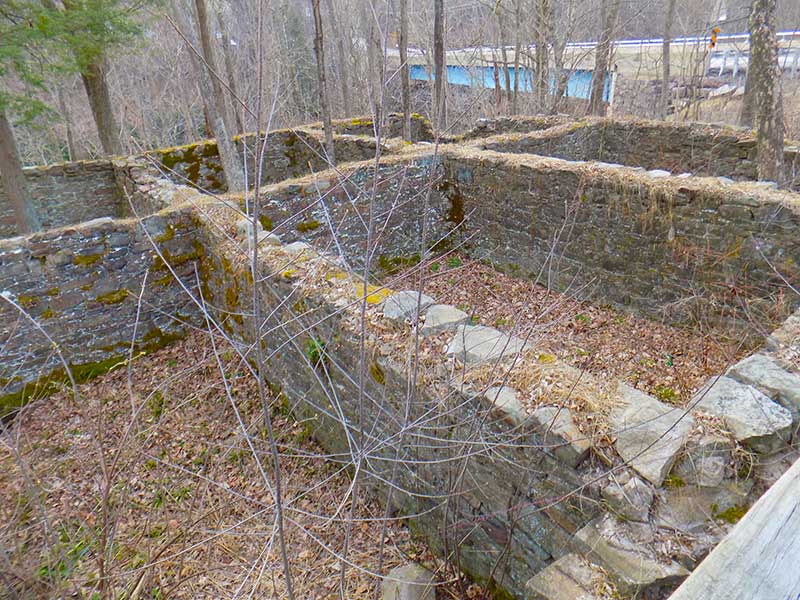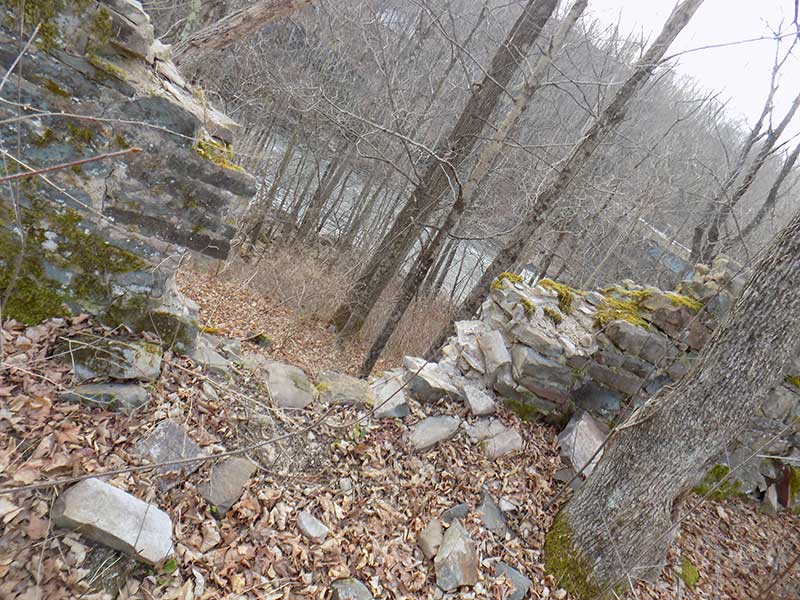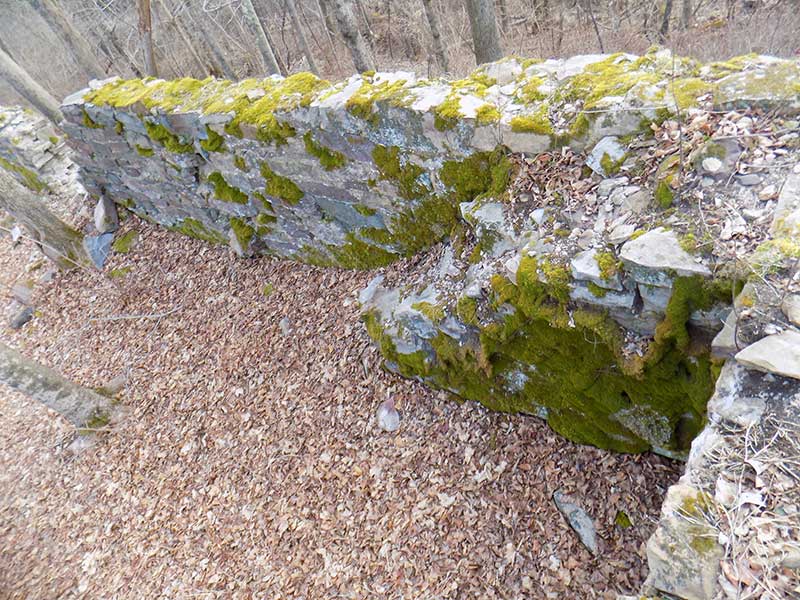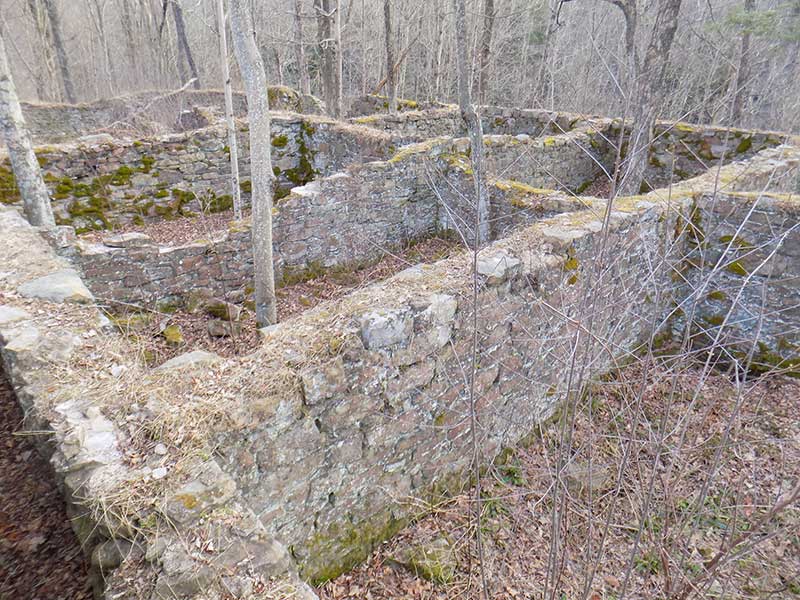
The old Lehigh Tannery can be found on Tannery Road at the Hickory Run State Park. It is easy to pass the pull off because there are so many places to pull over and explore along the road, and because the upper half of the old building is gone. All that remains is the base skeleton of what was once a huge building.
Steeped in the history of the Carbon County and White Haven area, the Lehigh Tannery is still a stopping place for many visitors who are fascinated with the history of a once booming region.

Largest Tannery in the United States
For a time, the Lehigh Tannery was the largest tannery in the United States from 1860 to about 1874. It produced 80,000 hides each year. [Source]

Perfect Trees for a Tannery
What made the location of the tannery so perfect was the abundance of hemlock and white oak trees. The bark from both of these trees was essential to tanning the leather hides. Men, called peelers, went into the forests each day to skin the bark off of these threes to take back to the tannery. So much tree debris was left behind, making the area prone to fires. [Source]

Lehigh Tannery was a Village
A village sprang up around the Lehigh Tannery and was aptly named after it. Old newspapers report on teachers chosen to teach at the Lehigh Tannery school and who was appointed to run the Lehigh Tannery post office (established in 1866) that can still be found at Hickory Run State Park. It is estimated that over 100 families lived in the area and worked for the tannery, the ice house, and other small industries that popped up to support what was once a growing village. [Source]

Shipping Hides
The hides made at the tannery were shipped out by the Lehigh Canal for the first two years. After the Lehigh Canal was destroyed by the 1862 Lehigh River flood, the tannery began shipping out the hides by railroad. [Source]

Two Fires
The Lehigh Tannery experienced two fires. The first happened in 1865 and the tannery had to be rebuilt. The second fire occurred in 1874. The building was burned down to the foundation and was never rebuilt because so much of the surrounding trees were destroyed and the supply for hemlock and white oak bark was not enough to run a profitable tannery any longer. [Source]

Cotton Mill
A short blurb in The Carbon Advocate (August 29, 1874) announced that, “The Lehigh Tannery will not be rebuilt. Parties are negotiating for the purchase of the site for the purpose of erecting a cotton mill.” The cotton mill was need built on the site. [Source]
There appears to be some discrepancy as to when this last fire took place with some online sources and one book stating that the fire took place in 1875 and newspaper articles showing that the fire took place in 1874. I feel that the old newspaper articles detailing the fire after it happened in 1874 would be the most reliable sources. The image above of a newspaper clipping comes from The Carbon Advocate, published on May 23, 1874. [Source]

The Mowing Machine
The 1800s are filled with incredible inventions for home use. William Decker, a resident of Lehigh Tannery is one of those inventors from long ago. In a short blurb in The Carbon Advocate (February 26, 1887), I found, “William Decker, of Lehigh Tannery, has invented a mowing machine which is said to surpass anything for the purpose now in market.” [Source]
A quick search through the patents and I found Patent US356574 dated January 25, 1887 for William T. Decker. [Source] Sadly, there is no mention of him in the written histories of lawn mowers.

A Cunning Swindler
For as long as there have been people, there have been con artists. It was reported in the Freeland Tribune (August 29, 1892) that a “cunning swindler” was operating in the area. The report states that the swindler went to an undertaker in Mauch Chunk (now known as Jim Thorpe) and made arrangements for his dead wife. The swindler, who gave his name as R. D. Ritter, told the undertaker that his wife had died of a heart disease and her body was located at Lehigh Tannery. Ritter made arrangements for her pickup and funeral. When it came time to pay the undertaker, the full cost of pickup and burial came to a whopping $36. Ritter only had a check for $42.18, so the undertaker accepted the change and refunded the difference ($6.18) in cash. Ritter left and the undertaker made the trip to Lehigh Tanner to pick up the dead wife only to discover there was no such person. When the undertaker tried to cash in the check, he discovered it was a fake check. [Source]

“Old Enough to Marry”
Very little news came out of the Lehigh Tannery village after 1900 and before the land was bought up in 1918. I did manage to find one mention of a wedding. Titled “Old Enough to Marry”, the short article tells readers that an 81 year old and a 70 year old were married in Wilkes Barre. Both had been married previously and were widows. The groom was from Lehigh Tannery. (Reported August 17, 1900.) [Source]

From Village to State Park
An Allentown millionaire, General Harry C. Trexler, started buying up the land, including the Lehigh Tannery village in 1918. His one desire was to turn the land into a public park to be enjoyed by everyone. He passed away in 1933. In 1935, Hickory Run was purchased by the National Park Service and is now Hickory Run State Park.

